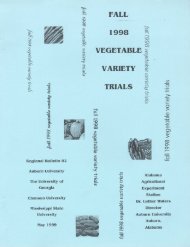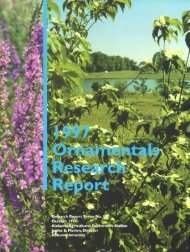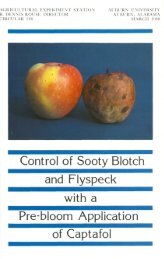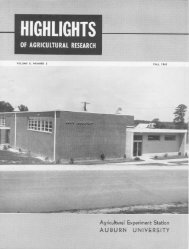MARKETING CHRISTMAS TREES - Auburn University Repository
MARKETING CHRISTMAS TREES - Auburn University Repository
MARKETING CHRISTMAS TREES - Auburn University Repository
Create successful ePaper yourself
Turn your PDF publications into a flip-book with our unique Google optimized e-Paper software.
8 ALABAMA AGRICULTURAL EXPERIMENT STATION<br />
TABLE 3. DISTRIBUTION OF <strong>CHRISTMAS</strong> <strong>TREES</strong> REPORTED, BY SPECIES AND BY SIZE<br />
OF CITY, 11 SELECTED MARKETS, ALABAMA, 1956<br />
NumberSpecies<br />
of cities Size of city Spruce Cedar Arizona All<br />
and fir 1 and pine 2 cypress species<br />
4 5,000-9,000 number 2,180 278 0 2,458<br />
per cent 88.7 11.3 0 100.0<br />
3 10,000-49,000 number 2,316 2,240 25 4,581<br />
per cent 50.6 48.9 .5 100.0<br />
1 50,000-99,000 number 1,517 1,930 0 3,447<br />
per cent 44.0 56.0 0 100.0<br />
3 100,000 or above............. number 23,938 12,522 244 36,704<br />
per cent 65.2 34.2 .6 100.0<br />
Total number 29,951 16,970 269 47,190<br />
Montgomery 3<br />
number 7,483 2,450 194 10,127<br />
per cent 78.9 24.2 1.9 100.0<br />
Mobile 3<br />
number 12,225 225 0 12,480<br />
per cent 98.2 1.8 0 100.0<br />
Birmingham 3 _____________________________ number<br />
per cent<br />
4,200<br />
29.8<br />
9,847<br />
69.9<br />
50<br />
.3<br />
14,097<br />
100.0<br />
1 Largely imported varieties from northern states or from Canada.<br />
2 Largely state-grown varieties or shipped in from southern Tennessee.<br />
3 Three large cities with population of about 107,000 in Montgomery, 129,000 in<br />
Mobile, and 326,000 in Birmingham.<br />
Tree Grading and Quality<br />
Quality of trees was studied only in a general way and was<br />
judged mainly on the basis of comments of retailers. All imported<br />
trees observed were graded by size. Bundle tags indicated height<br />
of trees in the bundle. Often individual tree tags indicated tree<br />
height and carried some promotional message and suggestions on<br />
how the trees should be handled at the retail selling point or at<br />
the home of the consumer.<br />
Standardization on bases other than height did not seem prevalent<br />
for natural-color trees. However, the imported ornamentals 5<br />
were very uniform in size, density, taper, balance, foliage, and<br />
general lack of deformity. No differentiation was made in price<br />
on any quality factor. All looked to be about one quality.<br />
The term ornamentals, as frequently used by the trade and as used in this<br />
publication, refers to small (usually 30 to 40 inches) black spruce trees, which<br />
were treated by the producer through spraying or dipping the tree in transpiration-retarding<br />
and tinting materials, and encasing the base of the tree in a sap-like<br />
fluid that tended to lengthen the tree's shelf and home-use life. Other types of<br />
trees were sometimes tinted at the market by or for the retailer or on order of the<br />
consumer. These were used for ornamental purposes, but they do not fall in the<br />
usual definition of "ornamental" Christmas trees.
















